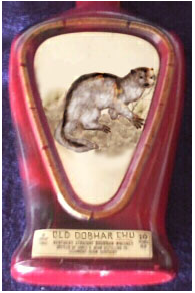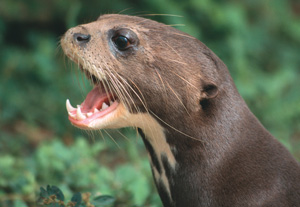Mystifying Mustelids
Otters, wolverines, skunks, and other weasel-like monsters
Waitoreke
The Waitoreke, also known as the Kaureke, is New Zealand’s cryptid claim to fame. In appearance it is not a very spectacular animal, it is just small, furry, aquatic mammal and said to look like an otter or beaver. The real enigma is in that New Zealand, a Mountainous island nation south of Australia, has no native mammals. The land mass broke away from a super-continent Gondwanaland 80 million years ago, and has had no land mammals since. The main fauna of the island is birds, which presumably arrived there by flight, and the only native mammals to speak of are bats, who got there the same way. Yet, despite this ugly fact, reports have dated back well into the 1700’s, and even into Maori folklore, of a small furry semi-aquatic creature.
The animals best eyewitness descriptions come form a 1855 writing by Reverend Richard Taylor, who first recorded an animal called a ‘musk-rat’ due to the strong smell is made. It was described as having a thick tail that resembled a beaver’s. A second witness described it as twice the size of a Norway rat, and having a flat tail. And yet third man described seeing streams dammed and finding little beehive-like houses with two entrances on the bank nearby. The animal was, ans still is, almost always sighted on the southern portion of the south island, at high elevations. There have been sightings further down in elavation, as James Cook’s crew described a cat-sized quadruped, with short legs, a mouse-colored coat and a bushy tail near the coast. Curiously, one crewmember described it as like a jackal. A report in 1861 desribes the sighting of otter-like tracks and a dark-brown rabbit sized animal. One report in 1971 describes the animal as having webbed feet and matchbox-sized tracks. Tunnels were later found in the same area.
The most popular of all theories regarding the identity of this animal is that the creature is some sort of otter, abet a rather small one. The otter does fit the beast's description on many points (and is indeed the reason we put it in the mustelids section) in having a long tapered tail, small ears, dark brown coloration, a round catlike head, webbed feet, short legs and a habit of eating fish. However, it still leaves the question of what variety of otter and how it got there. Some have suggested a pair of otters swam there, or drifted on flotsam. Freshwater otters that visit the ocean, such as the Chilean otter (Lutra feline), are fair candidates for this theory. While I suppose it is possible that these animals swam to NZ, the enormous distances that would have been crossed would realistically be too great for any freshwater mammal, even a very hardy one. Sea otters(Enhydra lutris), while more marine, are no more likely considering they would have to swim over a third the earths circumference to reach NZ, and probably could not be adapt to the new environment. It would also be hard to imagine the otter being the only land mammal to swim to the island for millions of years, if it was that simple. One alternative theory is that the Polynesians who settled the islands long before the Europeans arrival brought along some Asian otters, who Indonesians occasionally trained for catching fish, with them on there canoes as they did with dogs and a species of rat. Though there is no record of such an event, it is also possible the colonizing Europeans introduced European otters (Lutra lutra) along with the stoats, domestic animals, wild hogs, deer, possums, wallabies, and quolls the brought. It would also be possible they introduced some other animal, such as the mink(Mustela vison), muskrat(Ondatra zibethicus)or a European beaver (Castor fiber). The beaver is the second most popular theory, especially considering the reports of a scaly tails, dams and lodges. Since beavers do not typically visit the ocean, the chances that they would be caught in a current, or drift out on flotsam is even more unlikely than with the otter. There is no chance Indonesians or Polynesians ever came into contact with beavers, and so they could not have introduced them. As with the otter theory, they could have been introduced by Europeans, but we have the same lack of records, and the same question as of why, like other introduced animals, they have not grown in population and spread around the island, and have apparently stayed in the few remote isolated highlands. The fact that Waitoreke eat fish, and that the animal is too small to be a beaver, and has a tapered, rather than paddle-like tail, makes the beaver even more unlikely. The theory that the creature is actually a pinniped is the most radical yet. Even though a species of seal and sea lion are found on the shores of the island, neither they nor a freshwater-adapted relative of them could possibly pass the waitoreke’s description. The suggestion that a population of seals migrated upriver, shrunk incredibly, grew thick tails, claws, and began burrowing is pushing the envelope. It is possible some sightings were misidentifications of seals, however.The last theory towards the identification of the waitoreke is something altogether different: a monotreme. A monotreme (suborder monotremata) is any one of the few species of mammals that lay eggs, e.g. the platypus and echidna. Using the platypus as an example (as fossils show them to have been almost unchanged for the last 15 million years) we know a monotreme could have webbed feet, a tail that is fat, broad, tapering and hair-covered, and could even fit right into the waitoreke’s size range. A platypus with an otter like face, instead of a bill, would fit the waitoreke’s description perfectly. Even more intriguing is that the word ‘Waitoreke’ means ‘water-diver with spurs’, with ‘reke’ referring to a bone spur or quill. This defiantly suggests the spurs male platypus have on their hind legs. There is even a report, in 1838, coming from Te Taumutu to Walter Mantell, suggesting that the waitoreke lays eggs! And, like the waitoreke, platypus do live in streams and tunnel into river banks. Also, monteremes are though to have originated in Gondwanaland about 110 million years ago, before New Zealand split off from the continent. Perhaps a single species of montereme - like the tuatara - was living on New Zealand when it separated from the continent, and has been living there ever since. Unfortunately, this leaves us with almost as many questions as answers. Why has the animal not spread around the island and split into many different forms, as most types of mammals would have done? Why has it adapted to eating fish, rather than crustaceans, and why has it remained in a few hidden locations in the mountains?And why, regardless of what theory you choose to explain it, have we never found physical evidence of it(A skin obtained in 1868 is almost certainly that of a quoll) even though man has coexisted with it so long? For now, the creature’s identity is hidden.
Dobhar-chu
The Dobhar-chu, Irish for 'water hound', is Irelands most dangerous legendary animal. Sometimes called ‘the Irish Crocodile’, it is usually described as having a short, white or grey coat with a black or dark-brown stripe that runs dorsally down its back and neck, intersected by a perpendicular line just behind the shoulders, forming a ‘cross’ pattern. The animal is said to be very aggressive; it’s most famous descriptions coming from encounters in which it attacked people. One old tale tells of a man who saw the head of a dobhar-chu swimming in a lake, but mistook it for an otter. The animal, seeing the man, swam underwater to the shore, and then burst out, seizing the man by the elbow and causing the man fall down. The animal then took the man by the head and attempted to drag him underwater, but the man grabbed hold of a stone to stop him. The man was then able to take a knife from his jacket and stab the beast, causing it to release him and dive back into the lake. There is some physical evidence of the beast, though indirect, in the form of a tombstone in Glendale of Leitrim County, marking the grave of a woman named Grace and bearing an engraving of an otterlike creature impaled on a spear. According to local lore, she was killed by a water hound. The story goes that on September 24, 1722 (the date on the tombstone) Grace went down to the lake to wash some clothes. When she did not return, her husband went down to the lake to find her. To his horror, he instead found a water hound sleeping upon her bloody body. The man went to his house and retrieved a knife, and upon returning killed the animal with a stab to the heart. However, before the animal died it emitted a whistling noise, and a second water-hound appeared on the scene. The distraught husband and a friend quickly fled the area on horseback, with the second Dobhar-chu following closely from behind. They eventually turned to face the beast, and when it ran underneath the horses, they stabbed it to death.
If it were not for the tombstone, it would be easy to write this off as just another piece of Irish folklore. It is always possible, of course, that the woman simply had the beast inscribed on her tombstone, for some unknown reason, and a story was made up by a clever local prankster to fit around it. Even if the animal does – or at least did – exist, there is still no clear idea of what it might be. A giant otter would be a good start, as that indeed seems to fit the general description. American river otters (Lutra canadensis) regularly eat beavers, which average twice their weight, so a giant otter attacking humans is no stretch of the imagination. Since Ireland is noticeable lacking in native large predators, such as wolves and wildcats, some have suggested a giant species of otter developed to replace them. Also, since some reports describe the animal as hairless and slimy – possibly just misidentification due to wet fur, and still possible to find on mammal- a few have suggested that the animal is a giant labyrinthodont amphibian. However, since there has been no evidence, fossil or otherwise, that giant amphibians surviving from a prehistoric era nor giant otters ever lived in Ireland, or anywhere for that matter, all we can do is guess.
Below, an antique labeled glass bottle bearing a depiction of the legendary Irish water-hound.

Water tigers
Across the world there are numerous legends concerning 'water tigers', 'water panthers' ‘water hounds’ and other lesser-know and rarely recorded relatives of the dobhar-chu. They all seem to fanciful to bee real, but it would indeed be unusual if each culture developed them as mythical creatures seperatly. While recent accounts of such creatures are lacking, the parallels between myths are considered to be of intrest by some cryptid experts. Here are listed the more obvious ones.
In Patagonia, South America both the Lemisch and the Yaquaru are referred to as ‘water tigers’, the latter being described as yellow and woolly with a tapering tail and powerful claws, which it uses to drag large animals to the river’s bottom, and the former as puma-sized and rather otter like in appearance.They Aypa of Guyana in South America, is said to have a tiger-like head, large teeth, and a neck covered in scales. The appearance of scales may simply be a misidentification of the long fur around the neck when wet. The Maipolina of the same country was reportedly responsible for aquatic mauling in the 1960’s. The beast is described as 4 ft long with formidable claws on its feet, drooping ears, and dark, round eyes. It has short fawn-colored fur , with a witish chest, a 6’ wide whitish stripe running down it’s back, a tufted tail and prominent walrus-like fangs. No, I am not making this up. In the Central African Republic, the Water tiger is also known as the Muru-ngu (water leopard), Nze Ti Gou (water panther), Mamaime’(water lion), and even Ngoroli (water elephant). All of these names refer to some sort of large, long-toothed catlike aquatic creature. Some have theorized that surviving saber-toothed cats adapted to become aquatic, though this seems to me to be a bit of a stretch. To its support, however, is a cave painting at the Brackfontien Ridge, of the Orange Free State, depicting a walrus-like animal with a long tail. The Mourou N’gou is described as 12 feet long, larger than a lion, and shaped like a leopard, only with stripes. It has a long thick tail, short legs, and tusk-like teeth. The Nze Ti Gou, already mentioned above, resembles a leopard, is nocturnal, has red fur with paler markings (stripes or spots) and has a thunderous roar. It lives in the hollows of large rivers. The Coje Ya Menia or 'water lion' of Angola has a rumbling roar and is principally aquatic. It has long tusk like canines and can kill a hippopotamus with them. It is smaller than a hippo, and its tracks show the impression of toes. The Simba Ya Mia, Ntambue Ya Mai or Ntambo Wa Luy, of Zaire and the Ol-maima of Kenya, and the Nyokodoing of Sudan are all practically the same animal just mentioned by a different name. The Dingonek is often described as scaled, possibly due to wet fur.
The Pavawkyaiva of Arizona and New Mexico is reffered to as a water dog, but is very otter like in description. The California water-dog is a giant predatory otter-like animal said to live in turbulent rivers of northern California, according to native folklore. It is covered in spots, and drowns it’s victims in the river in witch it lives. The Ahuizotl is a cryptid of Central America and the Caribbean. It is described as both rodent-like and dog-like, and is said to drag people underwater and drown them with its tail.
Forest devil
The Forest devil of Yugoslavia is a ferocious weasel-like animal of local legend. An unidentifiable carcass was found in the town of Zenica, Bosnia, and locals immediately claimed it to be the forest devil. The carcass was pink and hairless, and had a small sharp-toothed mouth. The carcass was later ‘identified’ as a Pine marten (Martes martes) that had been skinned, though many doubt that identification, as the animals anatomy did not fit that of the marten. An experienced trapper thought it was most likely a fisher (Martes pennanti) which is basically a large species of marten. However, since fishers are only found in North America, this does not help us much in narrowing the animal down. Another person who examined the beast though the dentition was wrong for a mustelid, and so it must be some other type of small carnivorous mammal. The animal has been suggested as being an escaped population of European fishers, a new type of large mustelid, a misidentification of a normal animal, a cat, or a new larger subspecies or species of marten.
Below, a photograph of the famous mystery mustelid.

Other mustelids
The Montana mongoose is a single-case cryptid from Pablo, Montana, in North America. It was first found by a local family when their dog killed it and brought it inside the house. The animal was grey-colored with faint darker-grey bands on the tail, and spotting on the flanks. Prior to its killing by the dog, it had killed chickens without eating them and marked its territory around the area. The description defiantly suggests some variety of mongoose, though since no viverrids have ever lived in North America, it would be a first. Possibly it is an escaped mongoose, though since importing mongooses into the United States is illegal (even zoos must have special permission to own them) this is quite unlikely. It also could be a mutation of a local mustelid (e.g. mink, marten, ect.) or a new species thereof. There have even been a few reports of British wolverines from the United Kingdom. Several reports of large beasts from Wales certainly seem to fit that description, even though wolverines never have existed in Britain. These animals are possibly a hidden remnant population or a few escapade individuals. Most likely, however, the sightings are due to misidentifications of badgers. The strangest – though still quite probable – of recent cryptids comes from Java. In 1977 the Antara News Agency reported Giant skunks living in the jungles of north/central Java. They were described as being as large a German shepherd and able to climb trees. Reportedly, one was captured and killed by shepherds on the Ungaran Mountains in central Java. As far as I know, these animals have yet to be officially described and recognized by science. Since true skunks are not found outside of North America, we can assume this animal is probably a close relative of the Hog badger (Arctonyx collaris), or even more likely the Javan ferret badger (Melogale orientalis), as the latter is known to climb trees. Both of these animals, like skinks, can emit a foul-smelling fluid as a defense. The skunks have been suggested as being prehistoric survivors, or just giant subspecies of normal ferret badgers.
Phantom Felids
Cryptic Canids
Unknown Ursids
Mysterious Marsupials
News
Main Page
Email: ehtouzjian@direcway.com


